

Nielsen Norman Group Interviews and Press Coverage. Q&A: Jakob Nielsen on RWD, Google and the best ways to test your website (eConsultancy) eConsultancy in a broad-ranging interview with Jakob Nielsen on progress in usability, differences between phones and tablets, etc.
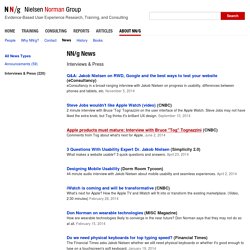
November 5, 2014 Steve Jobs wouldn't like Apple Watch (video) (CNBC) 2 minute interview with Bruce 'Tog' Tognazzini on the user interface of the Apple Watch. Steve Jobs may not have liked the extra knob, but Tog thinks it's brilliant UX design. The 100% Easy-2-Read Standard. Using 10 pixel Verdana made sense in a time when screens were 640 pixels wide.
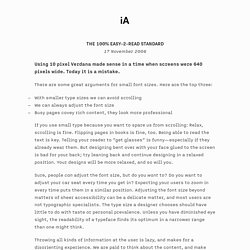
Today it is a mistake. There are some great arguments for small font sizes. Here are the top three: With smaller type sizes we can avoid scrollingWe can always adjust the font sizeBusy pages covey rich content, they look more professional If you use small type because you want to spare us from scrolling: Relax, scrolling is fine. Sure, people can adjust the font size, but do you want to? Throwing all kinds of information at the user is lazy, and makes for a disorienting experience. 1. To realize how small the text is on many websites, compare to a book that you feel comfortable reading, then change the font size until the type on the book and the screen are about the same size: It will look big if you hold the book right next to the screen, but it will look fine if you hold the book at a comfortable reading distance. 2.
Let your text breathe. The width of the column must be proportioned to the size of the type. Web Design is 95% Typography. 95% of the information on the web is written language.
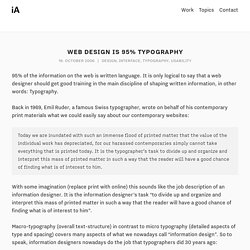
It is only logical to say that a web designer should get good training in the main discipline of shaping written information, in other words: Typography. Back in 1969, Emil Ruder, a famous Swiss typographer, wrote on behalf of his contemporary print materials what we could easily say about our contemporary websites: Today we are inundated with such an immense flood of printed matter that the value of the individual work has depreciated, for our harassed contemporaries simply cannot take everything that is printed today. Reactions to 95% Typography. An avalanche of comments, hundreds of applauding blog entries, honorable mentions from cooler and more sublime and hotter and higher places, forum discussions, translations in Chinese and partially in Italian and even blunt plagiarism was incited by one of my recent notes.
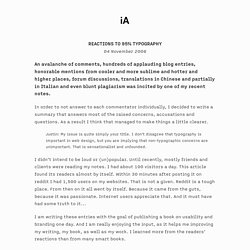
In order to not answer to each commentator individually, I decided to write a summary that answers most of the raised concerns, accusations and questions. As a result I think that managed to make things a little clearer. Justin: My issue is quite simply your title. Blog. Rich Typography On The Web: Techniques and Tools. Let’s face it: Web-safe fonts are very limiting.
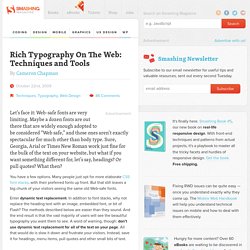
Maybe a dozen fonts are out there that are widely enough adopted to be considered “Web safe,” and those ones aren’t exactly spectacular for much other than body type. 50 Useful Design Tools For Beautiful Web Typography. Typography is elegant when it is attractive and communicates the designer’s ideas.

When chosen wisely and used carefully, it can be very effective in supporting the overall design. Designers are always exploring different techniques with type: some use images or sIFR to produce very beautiful typography, while others prefer CSS alone to get the typography just right. Today, we will look at 50 most useful typographic tools, techniques and resources for creating effective and expressive designs. We will also look at some hands-on typography tools that help designers and developers learn how to style their Web content, test it interactively and see the changes instantly.
These tools are great for experimenting with different font types for your website. Please feel free to suggest further tools and resources in the comments to this post. Typographic Design Patterns and Best Practices. Even with a relatively limited set of options in CSS, typography can vary tremendously using pure CSS syntax.

Serif or sans-serif? Large or small font? Line height, spacing, font size and padding… The list goes on and on. Typographic Design Patterns And Current Practices (2013 Edition) Good typography has always been a defining aspect of effective Web design, and this holds true especially for websites in which the emphasis is on presenting a large amount of content — specifically, articles, news and stories.
Whether for a magazine or international newspaper, the designer of any website that distributes a lot of content has always had to consider typographic details as seriously and thoroughly as a print designer would. In 2009, we conducted a survey of then current typographic practices1. Since then, responsive design techniques have clearly gained momentum and established their place in the landscape of CSS layout.
With the advent of mobile, new modes of browsing websites and reading text have emerged. Online publications have had to reevaluate how their content is presented on mobile devices. Relative readability / Wilson Miner. Why go so big on type?
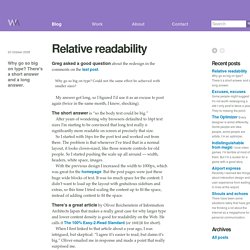
There's a short answer and a long answer. Greg asked a good question about the redesign in the comments on the last post. Why go so big on type?